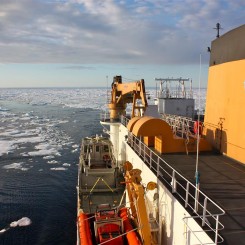This piece is included in Ran Dian’s print magazine, issue 4 (Winter 2016–2017)
All of us have in our veins the exact same percentage of salt in our blood that exists in the ocean, and, therefore, we have salt in our blood, in our sweat, in our tears. We are tied to the ocean. And when we go back to the sea—whether it is to sail or to watch it—we are going back from whence we came. — John F. Kennedy (1)
If we were to talk about an unruly and dark place, a place where people interact with one another without values, morals, or laws and forget their roots, we could be describing how ocean space has been portrayed for a long time. In ancient Greece it was believed to be a disadvantage to build a city near the sea. Aristotle talked about the dangerous influx from the sea and the threat it posed to good government (2), and Cicero said about coastal cities that “even their inhabitants do not cling to their dwelling places, but are constantly being tempted.” (3) Sailors have traditionally been depicted as an unregulated bunch whose profession encourages immoral behavior, not least because if they die at sea, their bodies will likely never be found and buried by the surviving relatives. This apocalyptic character of the ocean space resonated in India, where those who went out on the open seas, or “black waters,” would lose their varna status (4); and in China, where the Confucian elite (in the aftermath of Zheng He’s epic sea travels at the beginning of the fifteenth century) considered it improper to sail the ocean if one’s parents were still alive. (5) In short, a voyage on the open sea would only be undertaken by those who were forced by circumstance. In Europe, where the nation-state, law system, and sovereignty underwent a process of institutionalization from the sixteenth century onward, the sea space became a hellish mirror image that was helpful in showing people how the regulated system on land offered them, in contrast, a safe haven.
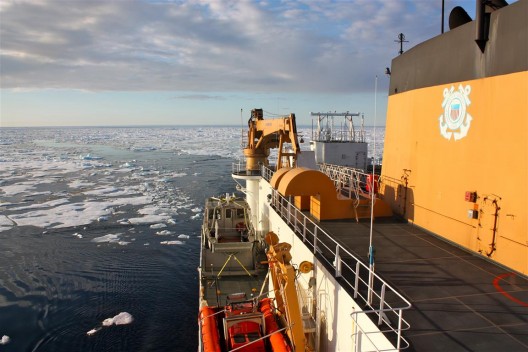
在ICESCAPE任务中凭借蒸汽通过北冰洋的美国海岸巡防队破冰船USCGC Healy号(WAGB-20),一项思考如何改变北极圈的环境的研究影响了海洋化学性质和生态系统,2011年7月(摄影:NASA/凯瑟琳·汉森)/ U.S. Coast Guard ice breaker USCGC Healy (WAGB-20) steaming through the Arctic Ocean during the ICESCAPE mission, to study how changing conditions in the Arctic affect the ocean’s chemistry and ecosystems, July 2011. Photo: NASA/Kathryn Hansen.
The ocean space borrows its designation as a non-space from the fact that it is by law a no-man’s-land: the sea belongs to everyone and to no one. This idea stems from the seventeenth-century concept of mare liberum conceived by the Dutch philosopher and jurist Hugo Grotius, who stated that the territorial borders of countries extend three nautical miles or five and a half kilometers into the sea (the distance that a cannonball fired from the land could reach)(6). Beyond this area the ocean was open to everyone to use for maritime trade, today called “international waters.” The British, at that time the most important competitor of the Dutch, were opposed to this idea. At the beginning of the twentieth century, Britain and France were keen on claiming ownership of sections of the ocean as part of their vast empires; following World War II, however, the world was organized in a manner largely based on Woodrow Wilson’s Fourteen Points, and the rule of free passage was reconfirmed and institutionalized within the United Nations. Today, ocean space is regulated by the 1982 United Nations Convention of the Law of the Sea, under which national territory extends twelve kilometers from the land (apart from claims based on an extended sea shelf). This agreement has been signed and ratified by most countries—although not, paradoxically, by the United States.
A consequence of this law is that identity can, in principle, only be based on land, though two postcolonial thinkers have proposed novel identities based on water space. In his 1995 book The Black Atlantic, Paul Gilroy gives slaves an identity based on their sea journey and identifies them as both European and black, since they belonged to the intercontinental trade triangle. Fiji scholar Epeli Hau‘ofa, on the other hand, refused to accept the separation of the Pacific Islands by the land-sea dichotomy that colonizing nations imposed and instead coined the term “oceanic identity.” He recognized water as territory and reunited the islands as one territory, thus returning to the way in which these islands have been perceived before, and he approached the sea as a space of connectivity for the Pacific Islands, but also any other place in the world.
Philip Steinberg and Kimberley Peters state that the ocean confuses the way we think about territory because we have historically defined as “territory” only places that are fixed and don’t move. (7) This issue becomes clear when you imagine that the ocean can freeze over, for example. Even though the territory is the same, it is the materiality of the ice (versus the moving water) that makes it possible to imagine regulating that territory, measuring it and fixing borders. In their essay “Wet Ontologies, Fluid Spaces: Giving Depth to Volume through Oceanic Thinking,” Steinberg and Peters propose an extension of the idea of “flat ontology” that abandons scale and looks at a geography of event-spaces instead. This also introduces the idea of a “wet ontology”—an invitation to let the movement of bodies of water question and enliven our understanding of space, time, and motion.
The ocean space also represents a contradiction of the economic and political principles on which the Anthropocene is presently structured: while there is a dictum of free trade, there is no sovereign law, and thus no rights and obligations that regulate the activities within that space. This absence of law has been productively exploited by libertarian venture capitalists who experiment with off-shore investment and labor law, or by hippy pirate broadcasters who make use of the vacuum to avoid land-based laws. Another, more serious consequence is that refugees who try to reach Europe by boat are left to drown outside territorial waters, where they float beyond the responsibility of European nations; at the same time the ports, as fringe areas where law begins and ends, are subject to rampant corruption.
In 2008, Reza Negarestani published an absorbing theoretical-fiction novel entitled Cyclonopedia: Complicity with Anonymous Materials, in which petroleum and its institutions play an important role in defining global affairs. I would argue that access to maritime passageways and large ports has often been a catalyst for war—not to mention the importance of ocean space in concealing military bases.
One might think, too, of several historical examples. During the First Opium War, when the Qing dynasty planned to abolish the lucrative opium trade established by the British between India and China, Britain used its naval power in what has since been called “gunboat diplomacy”: a demonstration of naval power on the coasts of China that led to concessions by the Chinese. In the early twentieth century, the fact that German U-boats attacked merchant ships caused the United States to enter World War I in April 1917. And in 1956, Egyptian President Gamal Abdel Nasser’s decision to nationalize the Suez Canal led to a crisis so severe that the newly formed United Nations was called on to defuse the situation. This incident also played a role in Britain and France giving up their colonies when they discovered that their actions were being more closely surveilled.
One consequence of ocean space as a political exception is that we do not see it as a territory that belongs to us or that we belong to. This lack of responsibility complicates the monitoring and regulation of what happens in the ocean. Before they obtain permission from the International Seabed Authority to carry out their work, companies mining in the ocean are required to partner with a nation-state so that its national laws apply. But the large sums of money circulating over the ocean, and the fact that it is often easy to conceal leaks, spills, and dumping, means that it remains a liquid El Dorado. At COP21, the United Nations Conference on Climate Change held in November–December 2015 in Paris, nation-states discussed a new agreement that would bind them legally. The need for global control is growing: there are predictions that all sea life will disappear by 2048, and that changes in the melt rate of the Greenland ice sheet are causing ocean levels to rise, with the result that some communities could be washed away.
The first place to disappear would be the Maldives, and it is predicted that this catastrophe will occur by the end of the twenty-first century. This probability was brought to international attention when the Maldives participated, for the first time, in the Venice Biennale in 2013. The curatorial collective Chamber of Public Secrets (CPS, established in 2003 by Khaled Ramadan) presented “Portable Nation: Disappearance as Work in Progress—Approaches to Ecological Romanticism,” a reflection on archiving the history of the Maldives in anticipation of its inhabitants becoming the first refugees of global warming.
The melting of the Arctic ice not only poses an ecological threat to the whole world, it could also lead to local geopolitical tensions when the disappearance of large ice sheets provides access to underwater resources. The five countries that border the Arctic—Denmark (via Greenland), Norway, Russia, Canada, and the United States—have exclusive ownership of a zone of 370 kilometers adjacent to their territory.(8) However, Norway, Russia, Denmark, and Canada have all launched extended seabed claims for several overlapping territories in the Arctic Circle that are estimated to contain 13 percent of the earth’s oil and 30 percent of its natural gas. There are also disputes regarding rights of passage and the demarcation of international seaways, an issue that will become increasingly important as the so-called North Passage opens up, thus rendering accessible a shortcut between Europe and China that will reduce the distance between Hamburg and Shanghai by 30 percent.
During the COP21 conference, an intriguing project called “The Current” was launched. Initiated by Francesca von Habsburg’s philanthropic organization TBA21 (Thyssen-Bornemisza Art Contemporary) in Vienna, “The Current” aims to contribute to new forms of knowledge production in order to protect the oceans and the communities on the Pacific Islands in particular. The three-year exploratory fellowship program will bring together artists, oceanographers, biologists, and other cultural and scientific producers on expeditions to the Pacific Islands while also supporting groups worldwide that protect sea life, such as fish sanctuaries or organizations that clean the beaches.
It would be premature to discuss the effects of a project that is still in development, but timely to reflect on an initiative in which artists and scientists are brought together for a collaboration with such high stakes. Art and science have long been separated in the educational system, to the extent that they have grown to exist almost despite each other. Art has seen a tendency toward research-based work in the past decade, while science, with proportionately more funding, has grown more aware of a need for collaboration since an ongoing drive for specialization has alienated it from the rest of the world and created divisions within disciplines. Bridging the gap between art and science in a collaborative lab might remind one of “The Anthropocene Project” at Haus der Kulturen der Welt that took place in 2013 and 2014, in which scientists and artists came together for exhibitions and conferences to speculate about a new geologic era.
In its statements about the project, TBA21 calls the artists “magicians of communication.” The compelling ways in which art can talk about climate change are evident in projects such as “Ice Watch,” presented by Olafur Eliasson and Minik Rosing during COP21, for which the artists transported twelve immense blocks of ice from Greenland to Paris and left them to melt in the Place du Panthéon. In “The Anthropocene Project” and “The Current,” artists not only translate a message but also come to represent the cultural segment of our civilization in the face of a threat. It would be risky to predict that their writings on the wall will sound louder than those of the scientists. A more likely and hopefully long-lasting effect could be that both fields become aware of the limitations of their own discipline, and allow themselves to learn from the other, to enrich themselves and expand internally by including new attitudes and changing what “art” or “science” can stand for from within. It is an outlook in tune with Steinberg and Peters’s sense of wet ontology: that “space” should also be able to include a body of water9. In order to close the historical gap between disciplines, more fluid approaches to defining art and science would be useful to create a new vocabulary in the face of new urgency.
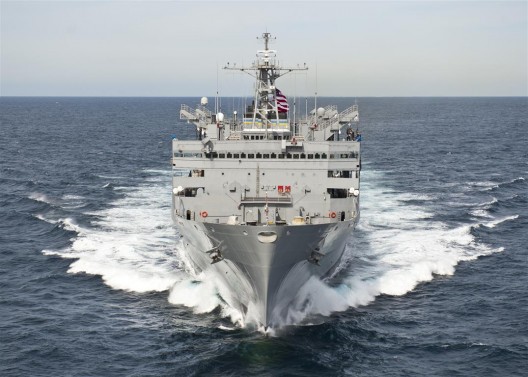
军事海运司令部快速战斗支援船只USNS Supply (T-AOE-6)通过大西洋(摄影:美国海军)/ The Military Sealift Command fast combat support ship USNS Supply (T-AOE-6) transits the Atlantic Ocean. Photo: US Navy
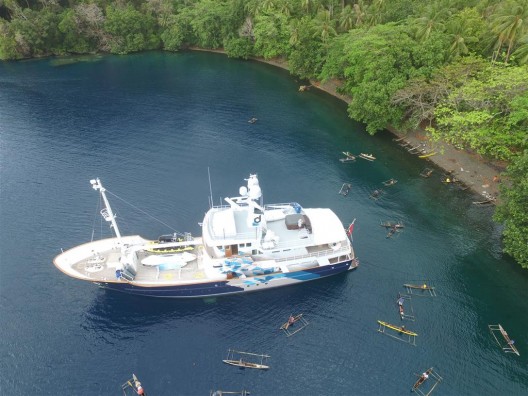
TBA21考察船Dardanella固定在了巴布亚新几内亚,米尔恩湾的蒂娜海滩(图片由TBA21提供)/ The TBA21 research vessel Dardanella anchored at Dina’s beach, Milne Bay, Papua New Guinea. Courtesy TBA21.
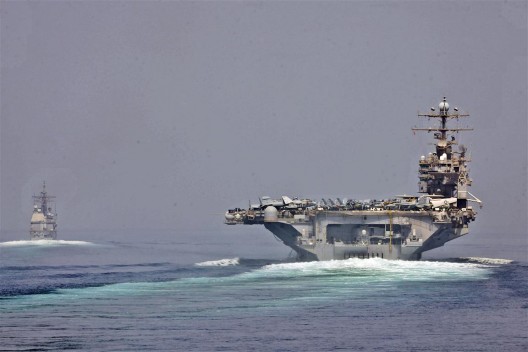
美国海军于2012年5月拍摄的亚伯拉罕·林肯号航空母舰和圣乔治角号航空母舰通过霍尔木兹海峡的照片
(摄影:美国海军)/ U.S. Navy photo of the USS Abraham Lincoln and USS Cape St. George transitioning through the Strait of Hormuz in May 2012. Photo: US Navy
Notes
1 John F. Kennedy, remarks at the America’s Cup Dinner given by the Australian ambassador, Newport, Rhode Island, September 14, 1962.
2 David Álvarez Jimenez Correio and Sergio Remedios Sánchez Correio, “Men of Sea: The Making of an Identity,” Revista Diálogos Mediterrânicos 7 (2014): 131.
3 Ibid.
4 Aisha Khan, Callaloo Nation: Metaphors of Race and Religious Identity among South Asians in Trinidad (Durham, NH: Duke University Press, 2004), 123. Varna status is a Hindu social stratification system that classifies society in four classes. Sea voyages were seen as an offense since the daily rituals could not be executed and travelers were far removed from the regenerating waters of the Ganges, which it was believed caused the end of the reincarnation cycle.
5 Evan Hadingham, “Ancient Chinese Explorers,” NOVA, January 16, 2001, accessed July 10, 2016, http://www.pbs.org/wgbh/nova/ancient/ancient-chinese-explorers.html. In 1477, after Zheng had made seven sea voyages, the Confucian court advisors who had been against sea travels and argued for frugality gained power. They voted against any more sea voyages on the basis that they were of no benefit to the state.
6 Lilian del Castillo, ed., Law of the Sea, From Grotius to the International Tribunal for the Law of the Sea (Leiden: Brill, 2015), 48.
7 Philip Steinberg and Kimberley Peters, “Wet Ontologies, Fluid Spaces: Giving Depth to Volume through Oceanic Thinking,” Environment and Planning D: Society and Space 33 (2015): 254.
8 Fiona MacDonald, “This map shows all the claims on the Arctic seafloor,” Science Alert, August 18, 2015, accessed July 10, 2016. http://www.sciencealert.com/this-map-shows-all-country-s-claims-on-the-arctic-seafloor.
9 Steinberg and Peters, “Wet Ontologies,” 259.
Heidi Ballet is a Belgian curator and researcher based in Berlin. Her research is focused on political and cultural understandings of the ocean space and its designation as a non-space which, in turn, serves to illuminate the reality humans have constructed on the land. This research interest is the basis for the Satellite exhibition series Our Ocean, Your Horizon at Jeu de Paume in Paris and CAPC in Bordeaux, containing solo shows by Edgardo Aragon, Guan Xiao, Patrick Bernier & Olive Martin and Basim Magdy, as well as the 2017 Lofoten Biennial for which Ballet is co-curator with Milena Hoegsberg.

